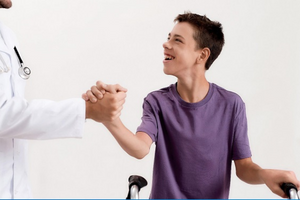NEURO REHABILITATION
Stroke Rehabilitation
Stroke rehabilitation is a process that helps stroke victims regain the function of their limbs. Stroke rehabilitation can be done in two ways:
– In-patient rehabilitation: This is where the patient stays in a hospital or other medical facility to receive therapy and care.
– Out-patient rehabilitation: This is where the patient receives therapy on an outpatient basis and goes home after their treatment.
Outpatient rehabilitation offers many benefits for patients, such as being able to continue with their daily routine and spend more time with family members. It also has lower costs than inpatient care, making it a more affordable option for people who have limited health insurance coverage or no coverage at all.

Spinal cord Rehab
Spinal cord rehabilitation is the process of restoring function to the spinal cord.
The spinal cord is a bundle of nerves that carries signals between the brain and the rest of the body. The spinal cord has two parts: a central canal that runs down its center and 31 pairs of nerves called spinal nerves that extend from either side. These nerves carry messages from your brain to your body, such as telling it to move or react to pain, heat, or cold. If you have an injury or illness that damages these nerves, it can lead to problems in how your body moves or feels sensations.
This is a very complicated topic with many subtopics but these keywords will help narrow down what someone might be looking for when researching this topic.

Rehab for Traumatic Brain injury
A traumatic brain injury is the result of a sudden trauma to the head and can lead to a variety of disabilities. This type of injury often results in long-term rehabilitation. The rehabilitation process is multifaceted and includes social, emotional, physical, occupational, and cognitive therapy as well as medication management. The purpose of this paper is to explore the various aspects of traumatic brain injury rehabilitation.

Vestibular Rehabilitation
Vestibular rehabilitation is a treatment that helps people who have dizziness and other balance problems caused by damage to the vestibular system.
The vestibular system is a complex set of nerves and structures in the ear that help us sense our body position, maintain balance, and keep track of time. Vestibular rehabilitation may be recommended when there are symptoms of dizziness or imbalance due to a problem in the vestibular system.
Vestibular rehabilitation exercises can be done at home or at a clinic with the guidance of an occupational therapist. The exercises are designed to retrain your brain’s ability to sense where your head is in space and help you maintain balance.

Balance & Gait Disorder
Balance and Gait Disorder is a condition where there is a loss of the ability to maintain balance. This can lead to falls and other accidents. It can be caused by many different things such as injury, stroke, or neurological conditions.
The rehabilitation process for this condition includes many different treatments that are tailored to the individual needs of the patient. These treatments may include physical therapy, occupational therapy, speech therapy and more.

Movement Disorder and Parkinson Disease Management
Parkinson’s disease is a movement disorder that affects the brain and causes tremors, slowness of movement, rigidity of muscles, and difficulty with balance.
Parkinson’s disease is a chronic condition that can lead to disability. There are different types of Parkinson’s disease treatment options available to manage symptoms and improve quality of life.
The medications used in Parkinson’s disease management are dopamine agonists which stimulate the release of dopamine in the brain or Levodopa which replaces dopamine that is lost in Parkinson’s disease patients.
The symptoms of Parkinson’s Disease may be managed by physical therapy, occupational therapy, speech therapy or other therapies.

Physiotherapy for Cerebral Palsy and Autism Disorder
Cerebral palsy is a disorder of movement, muscle tone or posture that is caused by damage that occurs to the immature, developing brain, most often before birth.
The physical therapy provided like Muscle training and exercises to increase strength, flexibility, balance, motor development and mobility.

